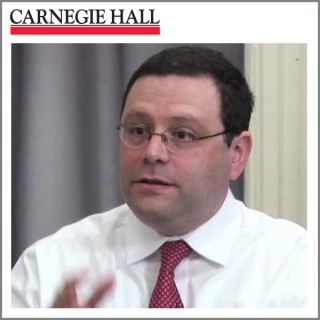
Zakir Hussain Workshop: Explore, Create, and Express Through Classical Indian Music
Follow Zakir Hussain Workshop: Explore, Create, and Express Through Classical Indian MusicIn the Zakir Hussain Workshop, experienced musicians of any instrument and style work to expand their existing knowledge through the guidance of tabla maestro Ustad Zakir Hussain and his colleagues.
- Jan 9, 2013 LATEST EPISODE
- infrequent NEW EPISODES
- 5m AVG DURATION
- 11 EPISODES
More podcasts from Carnegie Hall
Latest episodes from Zakir Hussain Workshop: Explore, Create, and Express Through Classical Indian Music

Zakir Hussain presents a critical element of Indian music, which is the unique tension and release compositional device known as "Tihai," that presents a fixed rhythmic phrase three times in sequence, with the last beat of the third phrase landing on the "Sam." Understanding the elements of Raga melody and Tala rhythm leads towards a culminating type of phrase unique Indian music, known as a "Tihai," which is used to build excitement, tension and ultimately a release on the first beat of the cycle "Sam."

A diverse group of instrumentalists learn fixed Raga melodies together and connect them within a rhythmic Tala cycle, in a complex arrangement that will eventually accompany Kathak dance. Zakir Hussain leads a rehearsal for an ensemble of participants whose instruments range from European violin, trumpet, cello and clarinet to tabla, drumset and various other percussion, teaching them a sequence of melodic lines based in a Raga, while holding a 7 beat rhythmic cycle underneath.

Steve Smith recites a common South Indian Classical percussion composition while holding the pulse with his feet at the drumset, and presents a recording of how he translated the composition from Indian percussion to be played on drumset alongside American jazz saxophone. Hearing the South Indian Classical (Carnatic) rhythmic phrases on drumset helps complete the bridge between Indian music and American music.

Steve Smith explains how rhythmic phrases of the same length can be interchangeable, and how changing the speed of phrases without changing the sequence of strokes can create interesting variations, while adhering to the underlying rhythmic cycle. Longer fixed compositions incorporate more complex phrases, repetitions, reduction, and other forms of variation, such as speeding up and slowing down.

Steve Smith demonstrates some of the spoken syllables of Indian percussion, and how they can be arranged using repetition and reduction, to ultimately accent the "Sam" (first beat) of the Tala. Spoken rhythmic phrases (bols), correspond to percussion strokes, while adhering to the underlying Tala (rhythmic cycles).

Pandit Shivkumar Sharma demonstrates the details of a fixed composition and how the sthayi (constant) melody along with accented notes, are important aspects to understand and present properly, when introducing the fixed composition. Sharma presents the key elements that define Raga Yaman: the set of notes being used, skipped notes within the ascending and descending scale, and key phrases to play along with phrases to avoid.

Pandit Shivkumar Sharma demonstrates the details of a fixed composition and how the sthayi (constant) melody along with accented notes, are important aspects to understand and present properly, when introducing the fixed composition. Sharma presents the key elements that define Raga Yaman: the set of notes being used, skipped notes within the ascending and descending scale, and key phrases to play along with phrases to avoid.

Pandit Shivkumar Sharma explains how to improvise while remembering the location and the importance of articulating "Sam" which is the first, and most important beat, of any rhythmic cycle (Tala). Understanding the significance of the first beat of a Tala, "Sam" (sum), is necessary to keep track of ones place in the rhythmic cycle.

Pandit Shivkumar Sharma presents the key elements that define Raga Yaman: the set of notes being used, skipped notes within the ascending and descending scale, and key phrases to play along with phrases to avoid. The structures and rules of Raga Yaman are critical elements to understand and follow in order to capture the true flavor of this common Indian Raga.

The Zakir Hussain Workshop was a chance for experienced musicians of any instrument and style to expand their existing knowledge through the guidance of tabla maestro Ustad Zakir Hussain and his colleagues.

Kala Ramnath guides participants through the Alap, opening section of a Raga performance, while introducing the sliding ornamentations (meend) and its importance in giving authentic nuance to the sound of Raga music. Proper sliding ornamentations give the strongest flavor of Indian Raga music, and is often heard in the Alap which opens the Raga presentation with pure melody, free from any rhythmic cycle (Tala)

















